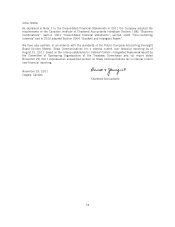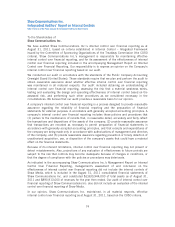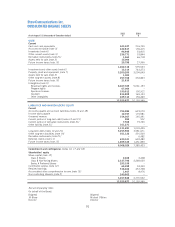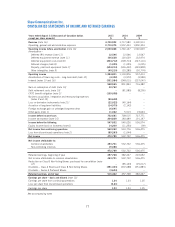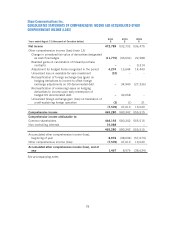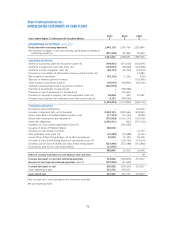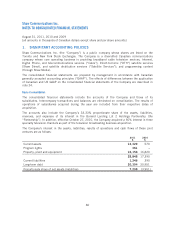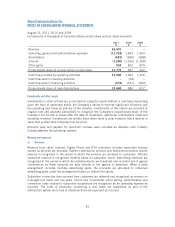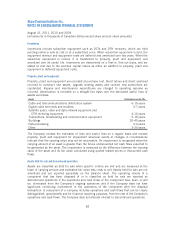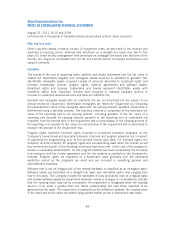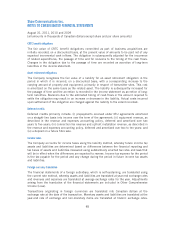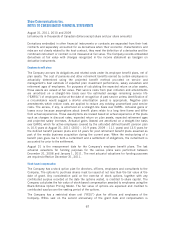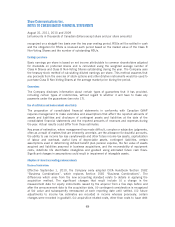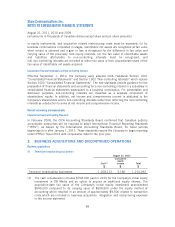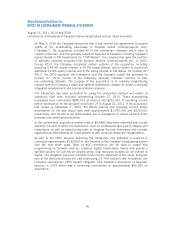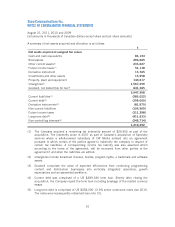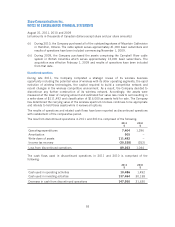Shaw 2011 Annual Report Download - page 87
Download and view the complete annual report
Please find page 87 of the 2011 Shaw annual report below. You can navigate through the pages in the report by either clicking on the pages listed below, or by using the keyword search tool below to find specific information within the annual report.
Shaw Communications Inc.
NOTES TO CONSOLIDATED FINANCIAL STATEMENTS
August 31, 2011, 2010 and 2009
[all amounts in thousands of Canadian dollars except share and per share amounts]
Inventories
Inventories include subscriber equipment such as DCTs and DTH receivers, which are held
pending rental or sale at cost or at a subsidized price. When subscriber equipment is sold, the
equipment revenue and equipment costs are deferred and amortized over two years. When the
subscriber equipment is rented, it is transferred to property, plant and equipment and
amortized over its useful life. Inventories are determined on a first-in, first-out basis, and are
stated at cost due to the eventual capital nature as either an addition to property, plant and
equipment or deferred equipment costs.
Property, plant and equipment
Property, plant and equipment are recorded at purchase cost. Direct labour and direct overhead
incurred to construct new assets, upgrade existing assets and connect new subscribers are
capitalized. Repairs and maintenance expenditures are charged to operating expense as
incurred. Amortization is recorded on a straight-line basis over the estimated useful lives of
assets as follows:
Asset Estimated useful life
Cable and telecommunications distribution system 6-15 years
Digital cable terminals and modems 2-7 years
Satellite audio, video and data network equipment and
DTH receiving equipment 4-10 years
Transmitters, broadcasting and communication equipment 5-15 years
Buildings 20-40 years
Data processing 3-4 years
Other 3-20 years
The Company reviews the estimates of lives and useful lives on a regular basis and reviews
property, plant and equipment for impairment whenever events or changes in circumstances
indicate that the carrying value may not be recoverable. An impairment is recognized when the
carrying amount of an asset is greater than the future undiscounted net cash flows expected to
be generated by the asset. The impairment is measured as the difference between the carrying
value of the asset and its fair value calculated using quoted market prices or discounted cash
flows.
Assets held for sale and discontinued operations
Assets are classified as held for sale when specific criteria are met and are measured at the
lower of carrying amount and estimated fair value less costs to sell. Assets held for sale are not
amortized and are reported separately on the balance sheet. The operating results of a
component that has been disposed of or is classified as held for sale are reported as
discontinued operations if the operations and cash flows of the component have been, or will
be, eliminated from the Company’s ongoing operations and if the Company does not have
significant continuing involvement in the operations of the component after the disposal
transaction. A component of a company includes operations and cash flows that can be clearly
distinguished, operationally and for financial reporting purposes, from the rest of the Company’s
operations and cash flows. The Company does not allocate interest to discontinued operations.
83


